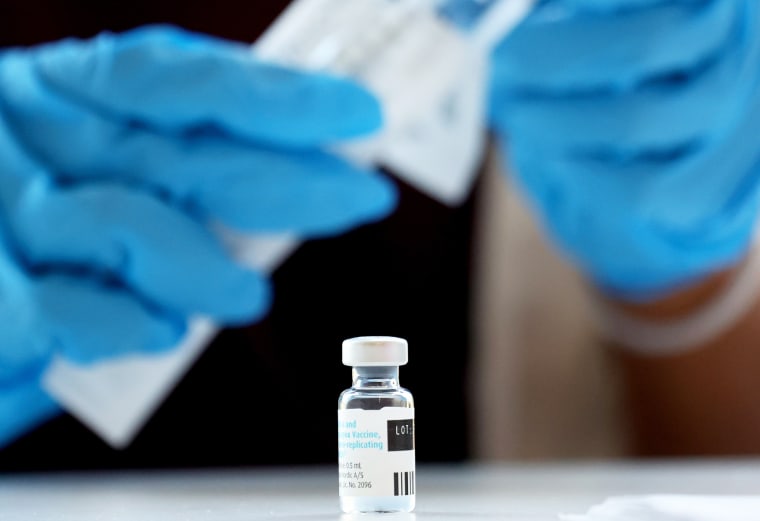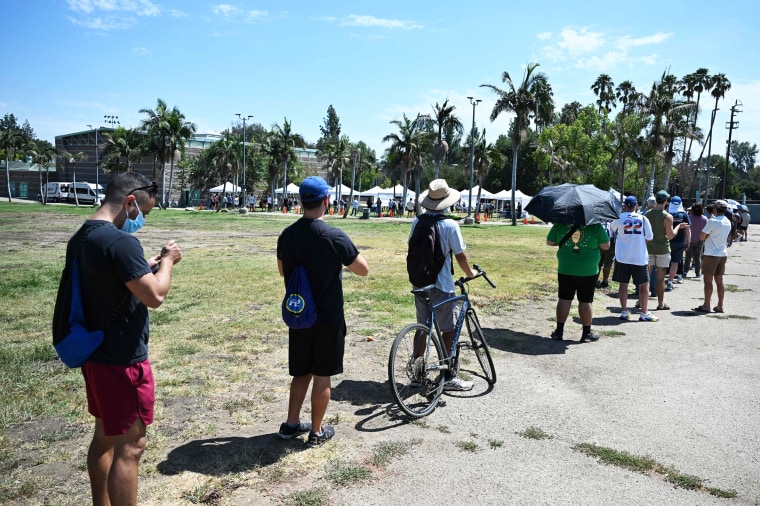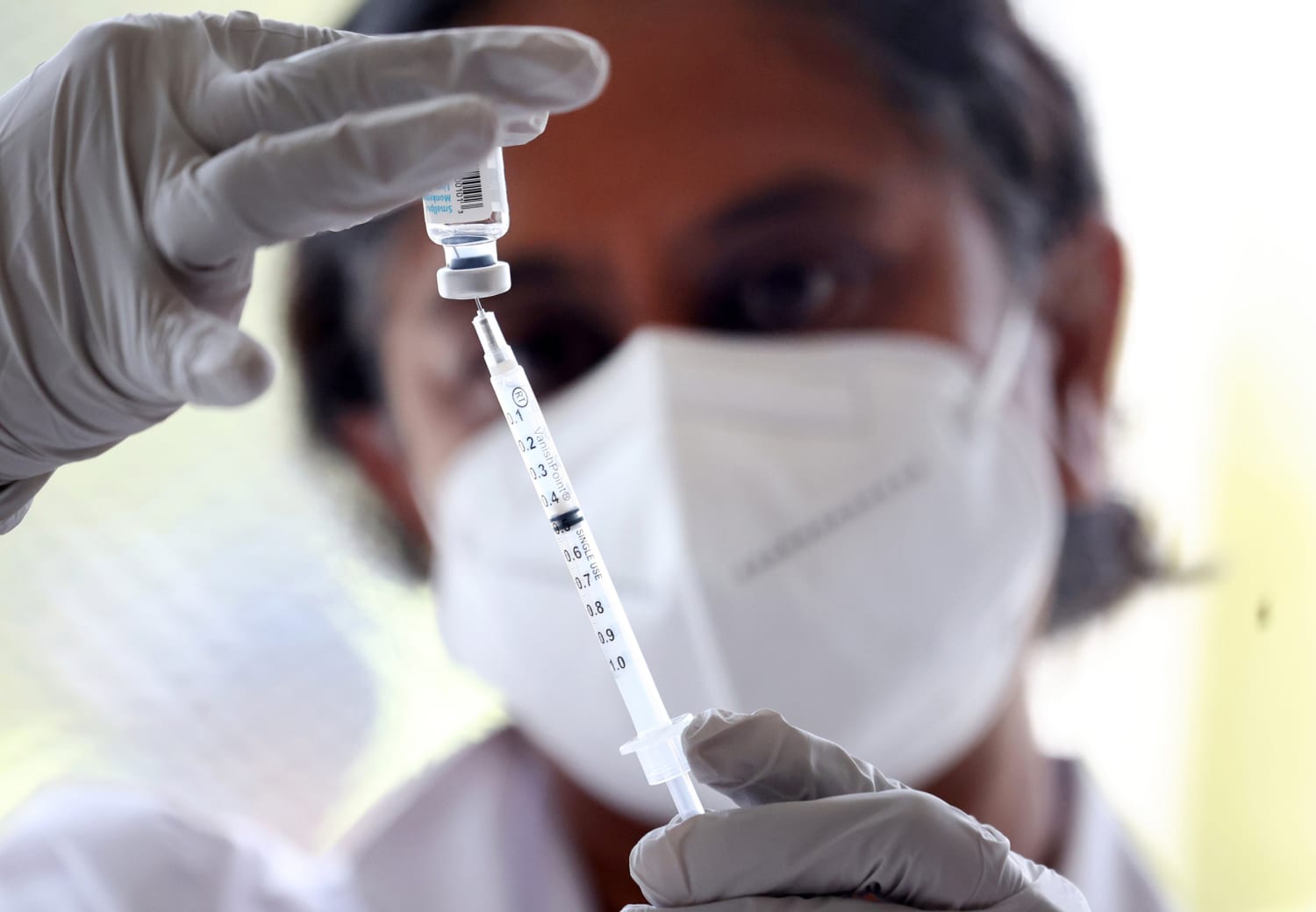The Food and Drug Administration issued an emergency use authorization on Tuesday that allows health care providers to split a single monkeypox vaccine dose into five.
To do so, the Jynneos vaccine must be administered intradermally, under the top layer of the skin. That’s a change from the way it has been administered until now: Those who already got the shot received it subcutaneously, meaning a needle was inserted into a layer of fat between the skin and muscle.
Health and Human Services Secretary Xavier Becerra issued an emergency declaration on Tuesday that allowed the FDA to authorize the intradermal method.
The move aims to give more people access to vaccines even though the U.S. supply remains limited.
“In recent weeks the monkeypox virus has continued to spread at a rate that has made it clear our current vaccine supply will not meet the current demand,” FDA Commissioner Robert Califf said in a statement. “The FDA quickly explored other scientifically appropriate options to facilitate access to the vaccine for all impacted individuals. By increasing the number of available doses, more individuals who want to be vaccinated against monkeypox will now have the opportunity to do so.”
In general, vaccines administered intradermally rely on a lower dosage to stimulate an immune response because the skin contains more immune cells than the fatty tissue underneath it.
“Basically you’re getting more bang for your buck,” explained William Moss, executive director of the International Vaccine Access Center at Johns Hopkins Bloomberg School of Public Health.
The FDA said Tuesday that health care providers should continue to administer the two Jynneos vaccine doses in the regimen 28 days apart. The emergency authorization also allows providers to administer shots subcutaneously to people under age 18 who are at high risk of monkeypox infections.
But some medical experts are concerned that the immune response from a smaller dose won’t last as long.
“Is this going to put us in a situation where we have to go back and do additional shots?” said Arthur Caplan, a bioethics professor at NYU Grossman School of Medicine.
Caplan said he fears a scenario in which “we stretch the vaccine out, we get an immediate response and people stop getting sick, but then three weeks later we’re back where we were.”

Moss said that as long as people get both shots in the two-dose regimen, an intradermal injection would probably yield a similar immune response to a subcutaneous shot.
“It’s with a single dose that I think there would be more concern about the duration of the immune protection,” he said.
Supply shortages led to dose sparing
The U.S. has recorded nearly 9,000 monkeypox cases this year.
Rochelle Walensky, director of the Centers for Disease Control and Prevention, estimated last week that there are up to 1.7 million people at the highest risk for contracting monkeypox right now. That’s based on the number men who have sex with men who are living with HIV or are eligible for preventative HIV treatment.
As of Tuesday, more than 620,000 of 1.1 million available doses have been shipped to cities across states. Places with the highest number of cases and at-risk populations are getting the largest allotments.
But the Biden administration was slow to order additional doses at the start of the outbreak, medical experts said. Though monkeypox started spreading in May, the U.S. didn’t order more Jynneos doses to add to its stockpile until June. More than 1 million doses were also held up at a Denmark manufacturing facility until late July.
Caplan said White House officials “seem to be in a bind because they’re in short supply, but they kind of put themselves in that situation.”
“We’ve created a crisis that maybe we could have avoided,” he said.
Moss said the discussion about splitting vaccine doses “is being driven by the supply shortage, not by any sense that this is somehow a superior method of administering a vaccine, although it could be.”
Nevertheless, he said, the intradermal approach makes sense in an emergency.
“When you’re in a situation where you need the vaccine, where the demand far outstrips the supply, this has historically been one of the strategies,” he said.
The World Health Organization, for example, called for giving partial vaccine doses in response to yellow fever outbreaks in Africa in 2016.
‘You’re trying something experimental’
Intradermal injections aren’t common in the U.S.
“Administering a vaccine intradermally is a little bit more technically challenging,” Moss said. “There may need to be some instructional materials and some additional training, but I feel that this is something that health care workers in the United States can handle.”

He added that health care providers who perform skin tests for tuberculosis may be familiar with the practice.Medical experts widely agree that administering the Jynneos vaccine intradermally won’t bring new safety risks.
Although the method was not tested in Jynneos’ clinical trials, a 2015 study found that people who received one-fifth of the standard dose intradermally produced a similar immune response to those who received a full dose subcutaneously.
Moss said intradermal shots might produce a little more redness, soreness, or discoloration at the injection site relative to a subcutaneous injection. The 2015 study found that 36% people who got the Jynneos vaccine intradermally had mild skin discoloration at the injection site for six months or more.
Caplan said it’s important to track people who receive a lower dose to make sure their protection doesn’t wane too quickly. Health care providers should tell patients that they aren’t administering the standard regimen, he added.
“If you do this, you’re going to have to basically say to people, ‘You’re trying something experimental,'” Caplan said.
Source: | This article originally belongs to Nbcnews.com










